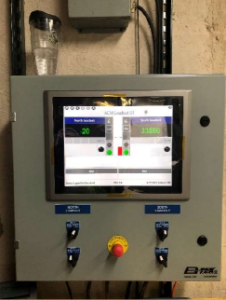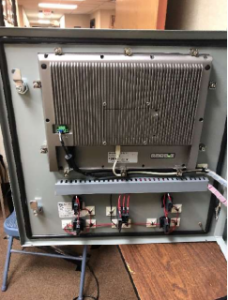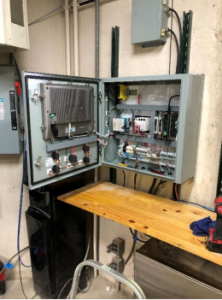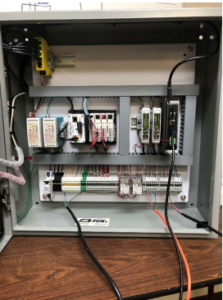Engineered Solutions Installs New Controller for Grain Loadout
The Original Controls:
The original controls for the grain loadout systems were the programmable scale indicator/controller model 920i manufactured by Rice Lake Weighing Systems. Each scale had its own 920i controller to perform truck loading, railcar loading/unloading and bin transfer functions. Each 920i was equipped with 16 channels of discrete I/O (110 VAC inputs/outputs) although only 7 channels were required for machine operation in this
case.
The Process:
The purpose of the 920i controllers was to allow an operator to perform several processes including truck loading, railcar loading/unloading and bin transfer functions in “Semi-automatic” mode. Due to the size/capacity of the scale hoppers, these scales are kept loaded to near capacity with grain and utilize the “loss in weight” net dispensing method rather than the “Draft to Target” method for all processes. This allows the plant to operate more efficiently and quicky for all processes. However, only a few of these processes are performed as desired in semi-automatic mode forcing the client to handle these functions manually most of the time.
The Problem:
The Rice Lake Weighing Systems model 920i programmable controller is a robust and mature product and is considered by many to be at the top end of scale indicator technology. However, when used in custom applications such as this, a programmable controller can only be as good as the software that was designed for it to run/operate. In this case, the software designed for this application did not perform all the required functions, and for some unknown reason, the backlighting on the displays (both controllers) were constantly failing causing the displays to become virtually unreadable.
The Solution:
After consultation with the client, one of the major complaints (pain points) about the current system was the lack of support from the scale company that originally installed the system for any requested changes, modifications and/or enhancements to the existing 920i software. Also, the backlighting on the displays was a major issue forcing the operators to bypass the 920i and opt for manual control. After several options were discussed, it was decided that instead of using programmable scale indicators, a more robust PLC/HMI approach would be the best fit. The new system would be comprised of the following components:
- Touchscreen HMI/PLC
- SQL Database
- Optional Web Interface
- Din Mount Scale Indicators




The new system is designed to separate the administrative responsibilities (SQL Database, Web Interface, Source Data Entry) from the operator functions allowing the operator to quickly navigate the HMI via touchscreen user interface to “Select” the desired information required to perform processes rather than having to perform data entry, although that is possible as well. The UI (User Interface) software is designed with Security Login Credential requirements (Users and Roles) that allows some users to perform administrative tasks while limiting others to operator tasks only.
The PLC interacts with the machine and communicates with the scale indicators to perform the loadout operations/processes and reports results back to the HMI, which stores these results in an SQL database. All devices communicate via TCP/IP Ethernet. A full set of CAD drawings/schematics was included with the project.




